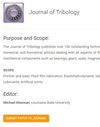Form Shear Stress (FSS) Correction in Bulk Flow Analysis of Grooved Seals Based on Effective Film Thickness
IF 3
3区 工程技术
Q2 ENGINEERING, MECHANICAL
引用次数: 0
Abstract
Bulk flow models for grooved annular seals provide computationally efficient static and dynamic response predictions, though heavy reliance on empirical relationships often leads to undesirable levels of uncertainty. The flow complexity caused by the grooves adds difficulty to shear stress modeling for these seals. This study seeks to improve shear stress modeling for grooved seals through the identification and quantification of the additional bulk flow shear stress contributions within the groove region. Through single groove computational fluid dynamics (CFD) simulations and an effective film thickness analysis framework, the additional groove shear stress component is identified as a form shear stress (FSS) due to its clear relationship to the effective film thickness behavior. The FSS is quantified as a correction to traditional shear stress definitions. Predictive models for the FSS are developed as functions of the ratio of circumferential to axial Reynolds number and the total resultant Reynolds number. Implementation of the FSS models into a simplified bulk flow method delivers leakage predictions for three seal cases within 10% of the experimental results and qualitative agreement in predicted circumferential velocity profiles while eliminating the need for an assumed groove loss coefficient. This is the first paper to utilize an effective film thickness based procedure to quantify and model the FSS component in grooved seal bulk flow analysis. The demonstrated predictive capability and widespread applicability of the models and approach presented in this paper provide an avenue for significant improvements in grooved seal bulk flow prediction accuracy through improved shear stress modeling.基于有效膜厚度的槽形密封体流量分析中的形状剪切应力修正
槽式环形密封的体流模型提供了计算高效的静态和动态响应预测,尽管严重依赖经验关系往往会导致不希望的不确定性水平。凹槽引起的流动复杂性增加了这些密封件剪切应力建模的难度。本研究旨在通过识别和量化凹槽区域内额外的整体流剪切应力贡献,改进凹槽密封的剪切应力建模。通过单槽计算流体力学(CFD)模拟和有效膜厚度分析框架,由于附加槽剪切应力分量与有效膜厚度行为有着明确的关系,因此将其确定为形式剪切应力(FSS)。FSS被量化为对传统剪切应力定义的修正。FSS的预测模型被开发为周向雷诺数与轴向雷诺数之比和总合成雷诺数的函数。将FSS模型应用于简化的整体流方法中,可以在实验结果的10%范围内对三种密封情况进行泄漏预测,并在预测的周向速度分布中实现定性一致,同时消除了对假定凹槽损失系数的需要。这是第一篇利用基于有效膜厚度的程序来量化和建模沟槽密封体流分析中的FSS成分的论文。本文提出的模型和方法的预测能力和广泛适用性为通过改进剪切应力模型显著提高槽式密封整体流量预测精度提供了一条途径。
本文章由计算机程序翻译,如有差异,请以英文原文为准。
求助全文
约1分钟内获得全文
求助全文
来源期刊
CiteScore
4.20
自引率
12.00%
发文量
117
审稿时长
4.1 months
期刊介绍:
The Journal of Tribology publishes over 100 outstanding technical articles of permanent interest to the tribology community annually and attracts articles by tribologists from around the world. The journal features a mix of experimental, numerical, and theoretical articles dealing with all aspects of the field. In addition to being of interest to engineers and other scientists doing research in the field, the Journal is also of great importance to engineers who design or use mechanical components such as bearings, gears, seals, magnetic recording heads and disks, or prosthetic joints, or who are involved with manufacturing processes.
Scope: Friction and wear; Fluid film lubrication; Elastohydrodynamic lubrication; Surface properties and characterization; Contact mechanics; Magnetic recordings; Tribological systems; Seals; Bearing design and technology; Gears; Metalworking; Lubricants; Artificial joints

 求助内容:
求助内容: 应助结果提醒方式:
应助结果提醒方式:


